Info
Subfamily: Panicoideae
Genus etymology: Cenchrus = "millet" [Greek]. However this is a misnomer, the only millet species in this genus is C. americanus, and this was treated as Pennisetum when Cenchrus was erected.
Species etymology: clandestinus = "concealed, secretly" [Latin] refering to the flowers hidden within the leaf sheaths
Photosynthetic type: C4 (warm season)
Nativity: naturalized - intentional
First recorded in Hawaiʻi: 1924
Map

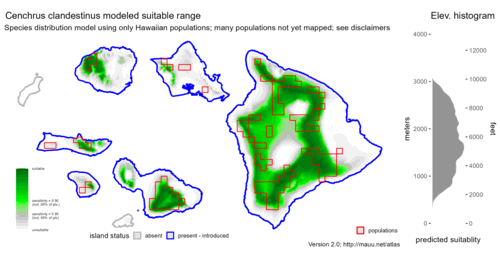
Inflorescence


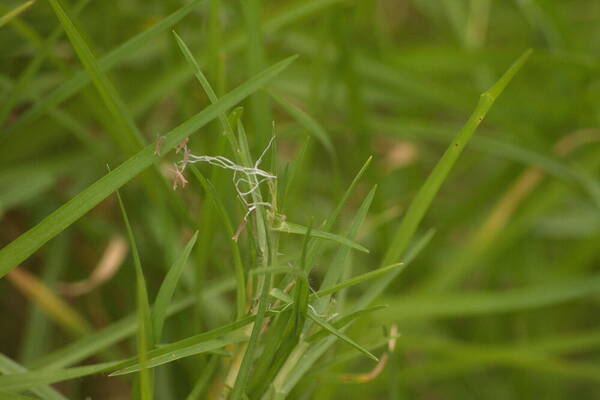
Plant
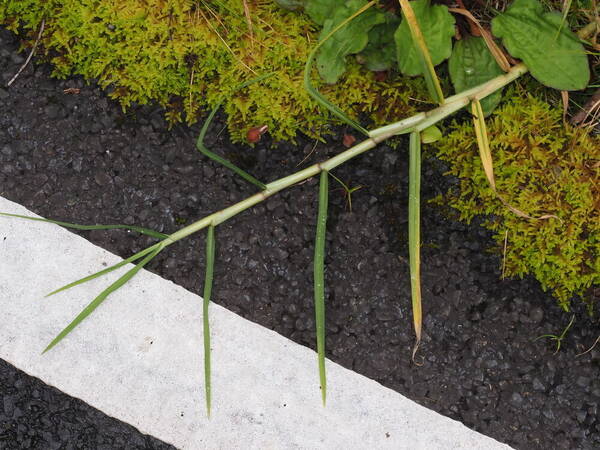





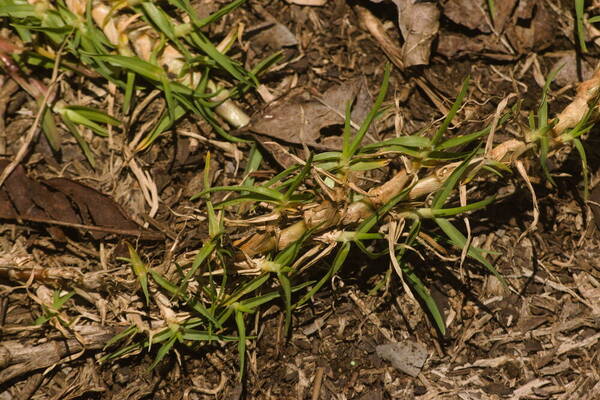





Habit

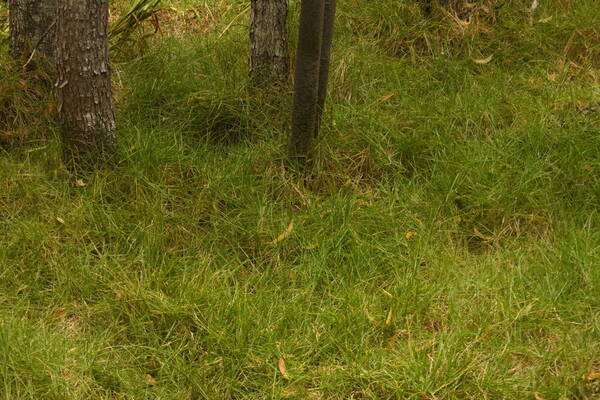

Spikelets



Landscape



Collar



Road damage

Description
sward-forming perennial, with slender rhizomes, and stout rampant stolons amply clothed with pale subinflated leaf-sheaths; culms 3–15(–45) cm. high. Leaf-blades 1–15 cm. long, 1–5 mm. wide, flat or folded. Inflorescence reduced to a cluster of (1–)2–4(–6) subsessile spikelets concealed within the uppermost sheath; involucre sparse; bristles delicate, 1/3–3/4 the length of the spikelet, scaberulous to ciliolate. Spikelets narrowly lanceolate, 10–20 mm. long; lower glume 0; upper glume ovate, 1–3 mm. long, rarely longer, sometimes suppressed; lower lemma narrowly lanceolate, as long as the spikelet, tapering, barren without a palea; upper lemma resembling the lower; stigma simple or shortly bifid, up to 3 cm. long, subplumose; anthers exserted on fine silvery filaments up to 5 cm. long.
(Description source: Clayton, W.D. & Renvoize, S.A. 1982. Flora of Tropical East Africa. Gramineae (Part 3). A.A. Balkema, Rotterdam. 448 pp. )
Sward-forming perennial with slender rhizomes, and stout rampant stolons amply clothed with pale sub-inflated leaf-sheaths. Culms 3–15(45) cm. high. Leaf laminae 1–15 cm. long, flat or folded. Inflorescence reduced to a cluster of (1)2–4(6) subsessile spikelets concealed within the uppermost sheath; involucre sparse; bristles delicate, 1/3–3/4 length of spikelet, scaberulous to ciliolate. Spikelets 10–20 mm. long. Inferior glume absent; superior 1–3 mm. long, sometimes suppressed. Inferior lemma as long as spikelet. Superior lemma resembling inferior; stigma up to 3 cm. long, subplumose; anthers exserted on fine silvery filaments up to 5 cm. long.
(Description source: Launert, E. & Pope, G.V. (eds.). 1989. Flora Zambesiaca. Volume 10. Part 3. Kew, London. 152 pp. )
Plants perennial; rhizomatous and stoloniferous. Culms 3-45 cm, decumbent, highly branching; nodes glabrous. Sheaths glabrous or pubescent; ligules 1.3-2.2 mm; blades 1-15 cm long, 1-6 mm wide, flat or folded, glabrous or pubescent. Panicles 2-2.7 cm, axillary, concealed in the sheaths; rachises flat, glabrous or scabrous. Fascicles 1-6; axes to 0.5 mm, with 1-2 spikelets; outer and inner bristles alike, 6-15, 0.5-10.9 mm; primary bristles 10-14 mm, usually not noticeably longer than the other bristles. Spikelets 10-22 mm, sessile or pedicellate, pedicels to 0.2 mm; lower glumes usually absent, sometimes to 0.5 mm, veinless; upper glumes 0-1.3(3.5) mm, veinless; lower florets sterile; lower lemmas 10-22 mm, 9-13-veined; lower paleas usually absent; upper lemmas 10-22 mm, 8-12-veined; upper paleas 2-7-veined; anthers 4.7-7 mm, long-exserted from the florets at anthesis. 2n = 36.
(Description source: Barkworth, M.E., Capels, K.M., Long, S. & Piep, M.B. (eds.) 2003. Flora of North America, north of Mexico. Volume 25. Magnoliophyta: Commelinidae (in part): Poaceae, Part 2. Oxford University Press, New York. 783 pp http://floranorthamerica.org/Cenchrus_clandestinus )
Vigorous perennials, rhizomatous and stoloniferous; culms prostrate, with erect branches at most nodes, up to 4.5 dm long (when not grazed), internodes short, densely clothed with overlapping sheaths. Sheaths keeled, glabrous or usually papillose-hirsute, especially on upper margins; ligule a dense ciliate rim, up to 2 mm long; blades folded or flat, 3-9 cm long, 2-5 mm wide, glabrous or with scattered long hairs, apex blunt and sometimes slightly bifid. Inflorescence a short, nearly concealed axillary spike, the 1-4 spikelets sessile, solitary at nodes of a short, flattened rachis, only slightly exserted from leaf sheaths; spikelets narrowly lanceolate, tapering to a slender apex, not disarticulating, each spikelet surrounded by an involucre of slender bristles of varying lengths, usually less than 1/2 the length of the spikelet, florets perfect, protogynous; first glume absent, second glume absent or reduced to a minute, nerveless scale; lemmas equal, similar, 19-22 mm long, first lemma empty and without a palea, 10-13-nerved, second lemma 10-12- nerved; second palea 2-7-nerved, 16-17 mm long; style 1, short-plumose, up to 3 cm long, exserted through the tip of the floret; anthers 4-7 mm long, at anthesis exserted from the floret on stiff, erect, white filaments up to 3 cm long. Caryopsis . pale brown, obovoid, somewhat dorsally compressed, 2.5-3 mm long, style persistent. [2n = 36, 54.]
(Description source: O’Connor, P.J. 1990. Poaceae, pp. 1481–1604. In: Wagner W.L., Herbst D.R. & Sohmer S.H. (eds.)., Manual of the flowering plant of Hawaiʻi. Vol. 2. University of Hawaii Press & Bishop Museum Press, Honolulu )